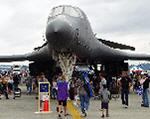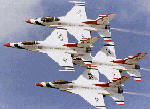
|
Description
| Manufacturer: | Vought | |
| Base model: | F8U | |
| Designation: | F8U | |
| Version: | -2N | |
| Nickname: | Crusader | |
| Equivalent to: | F-8D | |
| Designation System: | U.S. Navy / Marines | |
| Designation Period: | 1922-1962 | |
| Basic role: | Fighter | |
| Modified Mission: | All weather operation | |
| First Flew: | 1960/02/16 | |
| See Also: | ||
Specifications
| Length: | 54' 3" | 16.5 m | |
| Height: | 15' 9" | 4.8 m | |
| Wingspan: | 35' 8" | 10.8 m | |
Propulsion
| No. of Engines: | 1 | ||
| Powerplant: | Pratt & Whitney J57-P-20 | ||
| Thrust (each): | 17,500 lb | 7,936 kg | |
Performance
| Max Speed: | 1,322 mph | 2,128 km/h | 1,150 kt |
Recent comments by our visitors
| Jay Powelson Greybull, WY | If you haven't found it by now, there is a hand operated hydraulic pump in the R/H wheelwell. Use it after putting the wing incidence handle in the "up" position.
Spent almost half my career on F-8s. Great airplane!! 09/05/2010 @ 19:14 [ref: 29777] |
| john gabriel , WA | Museum of Flight [paine field] renovation, has a xf8u. Need to know how to get the wing raised with no power. Can we do it with hydraulic support equipment??
Looking inside access panel where ram is located is there a hydraulic line that can be accessed here? 02/28/2010 @ 18:26 [ref: 25798] |
| Randy Kelso Blanket, TX | I first met the F-8D while going through maintenance training and plane captain's school at Naval Air Station Miramar, California in Fighter Squadron 124 (VF-124), the west coast Replacement Air Group (RAG). It was love at first sight, but this encounter with the D model was not my first encounter with the F-8. I had grown up only a few miles from the Grand Prairie, Texas Vought plant and remember great numbers of F7U aircraft (the Cutlass, affectionately known among pilots as the "Gutless") and later, F-8 aircraft scattered around the plant and Hensley Field (NAS Dallas) next door. The F-8 was an obvious winner, even in the eyes of a child aviation buff.
Now, in VF-124 at age 18, I was learning the care and feeding of my favorite airplane and it was sheer bliss. I worked in the Aircraft Intermediate Maintenance Division (AIMD) on the MK-101 gunsight computer (an analog computer made up of magnetic amplifiers! Nobody seems to know what those are any more!). Then I was introduced to the Magnavox APQ-83 radar set used in the D bird. But for reasons unknown to me I was assigned to spend most of my time in the shop working on the AN/AAS-15 Infrared Detecting Set. It was a state-of-the-art solid state system, in stark contrast to the rest of the D bird's electronics which all seemed to be based on vacuum tubes. Later I was to discover that virtually nobody in the fleet actually used the IR set and most maintenance divisions didn't even bother to maintain the thing. I suspect that this was due to its lack of range information and its odd C-scan display, but there was also its awful reputation for being difficult to maintain. The main amplifier box was located just aft of the main gear, mounted to a large dzus-fastened swing-down door located almost directly under the engine's hydraulic pump. This meant that the line maintainer had to crawl under the bird on his back, release the dzus fasteners and swing the big door down... drenching himself in a gallon or more of red hydraulic fluid. In spite of all these things, later during the cruise, I did my best to keep every IR system on all our 15 or so birds in up condition. I suspected that the IR just might come in handy to a pilot who found himself needing to turn off his radar transmitter so as not to be emitting any radiation but with the IR still retaining the ability to lock on and track an airborne target. Nobody ever used the thing, but it was like a spare tire: it was there if it was needed. In April, 1964, after completing training in VF-124, I reported to my fleet squadron, VF-154, affectionately known as the Black Knights. I was assigned to work as a plane captain for a few weeks and found it to be (at least ashore) one of my favorite jobs. I can still remember some of the hand signals we used and some of the preflight/postflight checks we had to make. I was having a ball when I was assigned to do fire control line maintenance (radar, IR, gunsight). Later still I worked in AIMD, then we did a couple of little trips on the boat (USS Coral Sea, CVA-43). Then, on 7 December 1964 (Pearl Harbor Day) we cast off lines at Alameda and sailed for WestPac. Scuttlebutt had it we were going to Australia, but our dreams were shattered after departing Pearl Harbor and learning about a little fire that needed to be put out over in Southeast Asia, a little place called Vietnam. The pace was gruelling at Yankee Station and up in the Gulf of Tonkin (yes, Virginia, there was another Gulf War). Our first at-sea period lasted 50 days and this was written up in the cruise book being printed at the time as being some kind of a huge deal, but before our 331 day (that's about 11 months) cruise ended, we had done one at-sea period which lasted over 100 days. It was so serious that six, count'em, six of our first-cruise nuggets (new pilots) qualified as Coral Sea Double Centurions (each had made more than 200 recoveries [traps] in our F-8Ds). Now, you can imagine the amount of maintenance that had to take place to keep the birds flying. I don't know the F-8D's maintenance manhours per flight hour rating, but I do know that our guys worked awful hours on the airplanes. And we didn't come home with all the same birds we brought to the party. As I recall we lost six F-8Ds in combat (see http://www.geocities.com/randykelso/aircraftpageslide1.htm) and most of the others in accidents, but replacement pilots and aircraft did arrive. The F-8 had a documented accident rate far exceeding that of other carrier aircraft, but the pilots loved the plane. They said that it was a dream to fly and had a responsiveness and rate-of-climb that was like a rocket ship. And, by the way, the F-8 finished the war with the highest MiG kill ratio of any American aircraft. As for the pilots, we had only one who quit during the pre-cruise carrier qualification trials (CarQuals), but the rest of our guys were gutsy and courageous enough to stick it out in combat. Unfortunately, we lost two pilots killed in combat and one captured (the second Navy pilot captured during the war) who spent about 8 years being tortured by the enemy. Our squadron skipper was shot down over water near Bach Long Vi Island, injured, in a leaky one-man raft, and being bumped by sharks when he was rescued 45 hours later. The enemy had sent out patrol boats with search lights looking for him at night and we were fortunate to have retrieved him. But the F-8 Crusader, with its four 20mm cannon (Last of the Gunfighters) was considered old and outdated by that time and I nearly cried when we transistioned to the F-4B Phantom after returning to Miramar. From a fire control electronics maintenance standpoint I considered the Phantom to be outrageous and the Crusader a wonderful machine. Today the Phantom is revered as the greatest airplane of the Vietnam war, but one look at the kill ratio statistics will show that the F-8 Crusader was the real star of the war. 08/03/2006 @ 19:25 [ref: 13800] |
| Hall Martin , GA | My first flight in the F8U-2N, later redesignated F8D, was March 14, 1961. I was a new member in VF32. Jack Christianson was the Skipper. The "D" was an absolute dream to fly!
Cockpit layout was very organized. One of the features I enjoyed and really appreciated at night was the instrument panel lighting. The flight instruments were on a separate rheostat and could be turned up brighter then the other instruments. The original afterburner thrust of the J57P20 was 20,000 pounds! It was a hoot. However, after about six months of operating at that thrust level, the engine life was decreasing and the cure was to derate the engines to 18,000 pounds in burner. Initially there was a safety wire near full throttle to prevent the pilot from using all 20,000 pounds. Climbing to 40,000 feet in 2.5 minutes in 1961 was the ultimate. Strip lights were new on the "D" and wonderful for wingmen at night. Later, about 1962, a red fuselage light was added forward of the cockpit left side to aid the pilot during inflight refueling. Contrary to a report I read that the "D" came equipped with APC, in my three years flying it which ended in December 1963 I never saw an APC. My limited experience with APC later in the Naval Reserve was that I did not like it and felt more comfortable with manual throttle. The radar was very good but short ranged, only 20 miles. It was even good in the Map mode at low level. One of our Squadron Electronics Chiefs modified a unit that extended the range to 30 miles. However, this "mod" did not last long even though the pilot's wanted all the aircraft radar units modified. Vought Rep Jack Dressler cruised with us on our first deployment to the med. He showed us how to modify the F8 electrical system so that the refueling probe could be extended while using the emergency generator (Marquardt). He also taught us how to get an F8 started without an electrical unit by using the starter units battery. Each pilot carried a packet that included wire and directions on how to connect the starter unit battery for ignition. Occasionally a pilot diverted and the problem they usually had getting back to the ship was getting started. To my knowledge these squadron mods were never incorporated in to F8's, but we had 'em in 1961. The first six months we operated the "D" the airspeed indicators would freeze up every time a pilot flew in weather. We quickly learned the Angle of attack indicator references for Climb, cruise, 250 knots, 220 knots, and of course, approach speed. A modification to the pitot system tube that passed through a corner of the cockpit cured this. I loved my time in the F8, especially the "D". Hall Martin 05/09/2005 @ 21:59 [ref: 10166] |
Recent photos uploaded by our visitors





